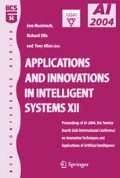Abstract
In this paper we present a system for automatic story generation that reuses existing stories to produce a new story that matches a given user query. The plot structure is obtained by a case-based reasoning (CBR) process over a case base of tales and an ontology of explicitly declared relevant knowledge. The resulting story is generated as a sketch of a plot described in natural language by means of natural language generation (NLG) techniques.
Access this chapter
Tax calculation will be finalised at checkout
Purchases are for personal use only
Preview
Unable to display preview. Download preview PDF.
References
R. H. and P. Gervás. Using design patterns to abstract a software architecture for natural language generation. In S. Juknath and E. Jul, editors, ECOP 2004 PhD workshop, 2004.
S. Bechhofer and F. van Harmelen et al. OWL web ontology language reference. W3C http://www.w3.org/TR/2004/REC-owl-ref-20040210/, 2004.
C. B. Callaway and J. C. Lester. Narrative prose generation. Artificial Intelligence, 139(2):213–252, 2002.
B. Díaz-Agudo, P. Gervás, and P. González-Calero. Poetry generation in COLIBRI. In S. Craw and A. Preece, editors, ECCBR 2002, Advances in Case Based Reasoning. Springer LNAI, 2002.
B. Díaz-Agudo, P. Gervás, and F. Peinado. A case based reasoning approach to story plot generation. In ECCBR’04, Springer-Verlag LNCS/LNAI, Madrid, Spain, 2004.
B. Díaz-Agudo and P. A. González-Calero. An architecture for knowledge intensive CBR systems. In Advances in Case-Based Reasoning-(EWCBR 2000). Springer-Verlag, 2000.
B. Díaz-Agudo and P. A. González-Calero. A declarative similarity framework for knowledge intensive CBR. In Procs. of the (ICCBR 2001). Springer-Verlag, 2001.
J. G. et al. The evolution of Protégé: An environment for knowledge-based systems development. Technical report, Stanford University, 2002.
C. Fairclough and P. Cunningham. A multiplayer case based story engine. In 4th International Conference on Intelligent Games and Simulation, pages 41–46. EUROSIS, 2003.
D. Grasbon and N. Braun. A morphological approach to interactive storytelling. In M. Fleischmann and W. Strauss, editors, Artificial Intelligence and Interactive Entertainment, Living in Mixed Realities, 2001.
V. Haarslev and R. Moller. RACER User s Guide and Reference Manual Version 1.7.7. Concordia University and Univ. of Appl. Sciences in Wedel, November 2003.
I. Heim. The Semantics of Definite and Indefinite Noun Phrases. PhD thesis, University of Massachusetts, 1982.
B. Magerko. A proposal for an interactive drama architecture. In AAAI Spring Symposium on Artificial Intelligence and Interactive Entertainment, Stanford, CA, 2002. AAAI Press.
K. R. McKeown. The text system for natural language generation: An overview. In 20th Annual Meeting of the ACL, pages 261–265, 1982.
J. R. Meehan. Tale-spin and micro tale-spin. In R. C. Schank and C. K. Riesbeck, editors, Inside computer understanding. Erlbaum Lawrence Erlbaum Associates, Hillsdale, NJ, 1981.
F. Peinado, P. Gervás, and B. Díaz-Agudo. A description logic ontology for fairy tale generation. In Language Resources for Linguistic Creativity Workshop, 4th LREC Conference., Lisboa, Portugal, 2004.
V. Propp. Morphology of the Folktale. University of Texas Press, 1968.
E. Reiter and R. Dale. Building Natural Language Generation Systems. 2000.
S. R. Turner. Minstrel: A computer model of creativity and storytelling. Technical Report UCLA-AI-92-04, Computer Science Department, 1992.
Author information
Authors and Affiliations
Editor information
Editors and Affiliations
Rights and permissions
Copyright information
© 2005 Springer-Verlag London Limited
About this paper
Cite this paper
Gervás, P., Díaz-Agudo, B., Peinado, F., Hervás, R. (2005). Story Plot Generation based on CBR. In: Macintosh, A., Ellis, R., Allen, T. (eds) Applications and Innovations in Intelligent Systems XII. SGAI 2004. Springer, London. https://doi.org/10.1007/1-84628-103-2_3
Download citation
DOI: https://doi.org/10.1007/1-84628-103-2_3
Publisher Name: Springer, London
Print ISBN: 978-1-85233-908-1
Online ISBN: 978-1-84628-103-7
eBook Packages: Computer ScienceComputer Science (R0)

